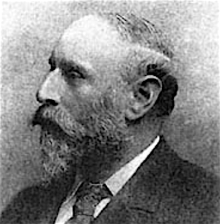
William Emerson [also known as Sir William Emerson] was born in Whitechapel, London, England on 3 December 1843 and was articled to William Gilbee Habershon (1818?-1891) and Alfred Robert Pite (1832-1911) of Habershon & Pite in London in c.1861. He then moved to the office of William Burges (1827-1881), where he worked on designs for a new art school for Bombay [now Mumbai], India. In 1866 Burges sent Emerson to Bombay with the plans for the building. The commission was cancelled, however, whilst in Bombay, Emerson produced designs for the city's Crawford Market, completed in 1871.
Emerson returned to England in 1869 and that year established his own architectural practice in Westminster, London. Most of Emerson's work over the next three decades was for buildings in India.
Emerson exhibited on three occasions at the Royal Academy in London - 1905, 1909 and 1911. He was elected an Associate of the Royal Institute of British Architects (ARIBA) in 1866, and a Fellow of the Royal Institute of British Architects (FRIBA) in 1873. In 1899-1902 he served as President of the RIBA. He was knighted in 1902 and died at his home, Eastcliffe in Shanklin, Isle of Wight, England on 26 December 1924.
A biographical file on William Emerson is available on request at the Enquiry Desk, Royal Institute of British Architects Library, London
Most of Emerson's architectural work was for buildings in India. These included Crawford Market Bombay [now Mumbai] (completed in 1871); All Saints Cathedral in Allahabad (1869-93); Girgaum Church, near Bombay (c.1870-73) ; Muir College in Allahabad (1872-78); Takhatsinhji Hospital in Bhavnagar (1879); and Nilambag Palace in Bhavnagar (1894-95). He also designed the Victoria Memorial in Calcutta [now Kolkata] (1903-21).
His few English commissions included the church of St Mary and St James in Brighton, Sussex (1877-79); Hamilton House, Victoria Embankment (London (1898-1901); 178-179 Queen's Gate, Kensington, London (1890); Clarence Wing of St Mary's Hospital in Paddington, London (1892-96); Royal Caledonian Asylum, Aldenham Road, Hertfordshire (1902); amd Faade designs for northern end of Waterloo Place, St. James's, London (1910). In 1885 he won first place in a competition to design Liverpool Cathedral, however, the scheme was not realised.
Davies, Philip Hugh. Splendours of the Raj: British Architecture in India, 1660-1947. London: Penguin Books, 1987
Directory of British Architects 1834-1914. Compiled by Antonia Brodie, et al. Volume 1: A-K. London; New York: British Architectural Library, Royal Institute of British Architects/Continuum, 2001
Gray, A. Stuart. Edwardian architecture: a biographical dictionary. London: Gerald Duckworth & Co., Ltd., 1985
Metcalf, Thomas R. An Imperial Vision: Indian Architecture and Britain's Raj. Oxford: Oxford University Press, 2007
‘Obituary’. The Builder vol. 128, 2 January 1925 pp. 2, 5
‘Obituary’. Royal Institute of British Architects Journal vol. 32, 10 January 1925 p. 155
‘Obituary’. Royal Institute of British Architects Journal vol. 32, 24 January 1925 p. 191
‘Obituary’. The Times 30 December 1924 p. 15